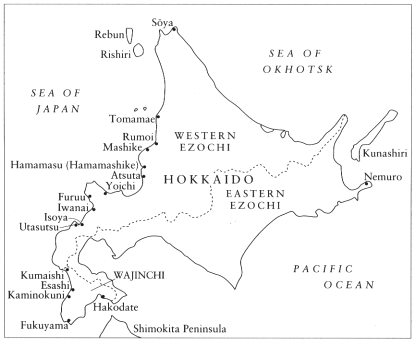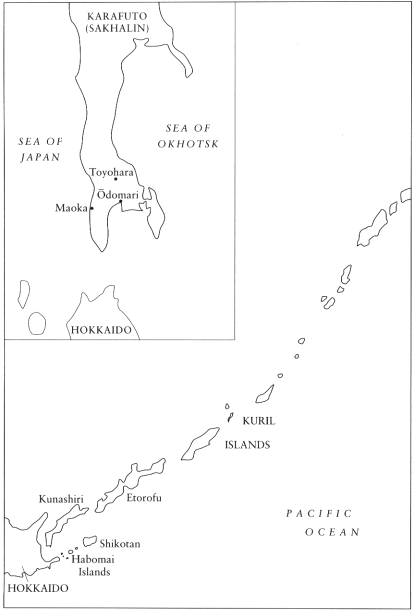Preface
The search for the roots of Japan's modern economic growth and industrialization has long occupied Western scholarship on the Tokugawa era (1603-1868). However various their methodologies and approaches, studies of peasant society and economy, demography, commercialization, urbanization, religion, and ideology reflect this concern, at least implicitly. It is a tribute to the efforts of a generation of scholars that we are now ready to proceed to a new level of analysis—that is, instead of merely asking if modern Japan's roots lay in the Tokugawa period, we can now look at how the nineteenth-century transformation of the Japanese economy actually took place.
In the chapters that follow I shall illustrate the indigenous origins of capitalism in nineteenth-century Japan with a case study of the fishing and fertilizer-processing industry of the northernmost island, Hokkaido. Let me introduce the study with a brief listing of what I consider to be its five principal objectives.
First, my concern here is to identify the origins and trace the development of capitalism as a mode of production. Rather than frame my discussion in terms of aggregate growth or some other quantitative measure of economic development, I focus on qualitative changes in the basic structure of social and economic relations, particularly the organization of production.
Second, I have employed the concept of proto-industrialization (rural manufacturing for long-distance trade) to clarify the relationship between
state institutions and social and economic structural change. The proto-industrialization model helps us to see how a feudal institutional environment can give rise to capitalist production and how, in turn, nascent capitalist production can pressure state institutions to adapt to economic change.
Third, because the Hokkaido fishery was not directly affected by Japan's opening to the West in the 1850s, the nineteenth century can be treated as a single, coherent unit, in which the critical connections between Tokugawa proto-industrialization and Meiji (1868-1912) capitalism are revealed. The continuities of demand, labor, and technology in the fishery make it possible to highlight social and economic structural changes and the role of state institutions with much greater clarity than in analyses of industries, such as textiles, transformed by the impact of Western technology and the world market.
Fourth, in examining the Hokkaido fishery I bring into focus social groups like fishers and the Ainu people that heretofore have been excluded from Western narratives of Japanese history. The physical mobility of fishers and the interregional economic and social integration engendered by their activities further undermine the surprisingly resilient stereotype of a Japanese peasantry tied to the land. The presence of the Ainu in the fishery raises questions concerning the nature of the Tokugawa polity and of Japanese ethnicity.
Finally, this study challenges well-established notions of center and periphery in Japanese history. By discarding the assumption that the geographical center of Japan was similarly the source of all important social and economic developments, I am able to locate critical changes in social and economic relations in ostensibly "backward" areas. In particular, I explicitly reject the prevailing image of Hokkaido as an untamed frontier, neither politically nor economically a part of Japan before 1868.
I pause here to offer a word of thanks to the many people and institutions who have given me guidance and assistance over the course of researching and writing this study. Marius B. Jansen and Sheldon Garon have been unfailing in their support for this project and indeed all of my professional endeavors. Martin Collcutt, Gilbert Rozman, Saito Osamu, and Anne Walthall read the dissertation on which this book is based and offered numerous suggestions for improvement. I owe special thanks to Gary Allinson for his thoughtful reading of two versions of the manuscript and for his encouragement during the difficult transition from dissertation to book. Ralph Meyer helped me with computer graphics and Koko Fujita Howell made the drawings of nets that adorn Chapter 3. My
father encouraged my initial interest in things Japanese and taught me to respect serious scholarship and clear writing; my parents' financial and moral support saw me through my study of the Japanese language.
A number of people gave me invaluable advice and assistance while I was doing archival research in Japan. Professor Nagai Hideo smoothed the way for me to do research in Sapporo and generously shared his extensive knowledge of Hokkaido history with me. Professor Nagai and Professor Tanaka Akira both graciously allowed me to sit in on their seminars on modern Japanese history at Hokkaido University. Kasahara Akiko, Yamamoto Kazushige, and the other members of the Department of Japanese History at Hokudai expended much time and effort on my behalf as I puzzled my way through the labyrinth of Japanese academic bureaucracy. The staffs of the Hokkaido University Library, Hokkaido Prefectural Library, Hokkaido Prefectural Archives, Hakodate Municipal Library, Aomori Prefectural Library, and Iwate Prefectural Library were uniformly generous with their time and knowledge.
I was welcomed into the community of scholars working on Hokkaido history in Sapporo. I want to express my thanks to all the members of the Kindai Nihon to Hokkaido Kenkyukai and to Seki Hideshi, Hasegawa Shinzo , and Katada Seishi in particular. Special thanks go also to Tajima Yoshiya of Kanagawa University, who shared with me his extensive knowledge of the contract-fishery system.
Perhaps my greatest debt in Japan is to the former curator of Hokkaido University Library's Resource Collection for Northern Studies (Hoppo Shiryoshitsu ),Akizuki Toshiyuki. For more than thirty years until his recent retirement Mr. Akizuki worked to build the world's finest collection of research materials on Hokkaido and northeast Asia. His encyclopedic knowledge of the history, geography, and cultures of the northern Pacific region—and his readiness to share it with me—helped me spot the red herrings before they colored my whole work. His capable assistant, Yoshida Chima, helped me locate sources, introduced me to other scholars, and generally made me feel at home in the archives.
If it were not for the generous financial support of a number of institutions I would not have been able to undertake the research and writing of this study. A dissertation research fellowship from the Japan Foundation allowed me to go to Hokkaido in the first place, and a subsequent year as a Whiting fellow made it possible for me to concentrate on writing once I had emerged from the archives. A grant from the University Research Institute of the University of Texas at Austin supported me while I reworked the dissertation into a book.
Preface writers as a rule save the most important acknowledgement for last; I am no exception. My wife, Koko Fujita Howell, has endured every bump in the rocky road of academic life with grace and good humor. With love and gratitude, I dedicate this work to her.
A Note on Dates
I have used the lunar calendar to express dates through 1872 and the Gregorian calendar for those after 1 January 1873. Dates under the lunar calendar are expressed as year/month/day; thus, 1782/11/6 is the sixth day of the eleventh month of 1782.
A Note on Weights and Measures
I have converted weights and measures to the metric system throughout. Herring meal is the thing most often weighed and measured here. One koku of herring meal equals 0.75 metric tons or about 1,654 pounds. A metric ton is about 2,205 pounds. A handy source for metric equivalents of other units is Watanabe Shigeru, ed., Hokkaido rekishi jiten (Sapporo: Hokkaido shuppan kikaku senta, 1982).

Map 1.
Hokkaido

Map 2
Karafuto and the Kuril Islands